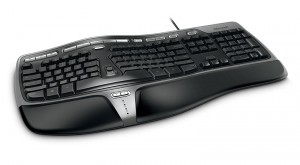As a professional developer, I spend a lot of time with my hands on a keyboard.
Many many years ago, I was privileged to use an IBM Model M keyboard. Â I really enjoyed it, but trends changed. Â Microsoft came out with a fancy looking ergonomic keyboard and I had the chance to try it out. Â I liked the shape, but the keys – especially the space bar – were rather unpleasant. Â So, I went back to the Model M. Â I even managed to pick up a “space saver” TKL (“ten key” less) version, which is designed more for server racks

Over time, though, I just used whatever was attached. Â My jobs at the time just had a bundled Compaq or Dell keyboard and I just used it. Â Unless they keyboard was really terrible, I managed and didn’t make a fuss. Â When I started working for myself, I tried out a Microsoft Natural Ergonomic 4000. Â They had come a LONG way since the first one, the key feel was much better.
After a little while, I switched to a Mac. Â The Apple keyboards are actually pretty good, better than most, but they just don’t have much key travel, this is the nature of their low-profile design. Â I plugged in my Microsoft Ergonomic again. Â IÂ decided I liked it enough to even get a second one after the first one wore out.

All of this time, I still had my Model M. Â It stayed with me through about 5 moves, stuck in a closet, still has the exceptionally long PS/2 cable (still coiled up, it’s probably 10′ long). Â It’s heavy, it’s fairly loud. Â It uses “buckling springs” under the keys that gives a unique progressive resistance and feedback.
I never had any problems with my hands and wrists with this keyboard. Â I figured it must give your hands enough strength to keep healthy, or something like that. Â But, it was PS/2. Â So it limited my opportunities to use it.
I started wondering if I could get a better keyboard, a mechanical keyboard rather than a membrane keyboard. Â This is the only way to get really good feedback from each key. Â Unfortunately, cheap keyboards are so popular because they’re, you know, cheap. Â A good keyboard starts to cost something. Â I thought about it though, and realized I would pay a fair bit for a really good mouse but for some reason always cheaped out on a keyboard that I use much more… so… I set myself a slightly higher budget and started to search.
It seems like most of the focus these days for these higher-end keyboards is on gamers.  One main feature is called n-key rollover, so you can hit a whole bunch of keys and have them all register.  (Here’s a test to try your own keyboard: hold down both shift keys and try to type “the quick brown fox jumps over the lazy dog”.  Yes, this is challenging.  If you don’t have a similar feature, you may be dismayed to see many letters missing).
There are a number of flavours of key switches, mostly from the Cherry company, they are identified by a color, such as black, blue, red, etc. Â It’s very hard to know what kind you want, because very rarely are these keyboards available to try in stores! Â I managed to find one or two, and gave it the swat test, and did not like it at all. Â (It seems like the one I tried were the blue variety).
Other features are cool, but not that necessary for work, like LED backlighting. Â I didn’t need to see this feature, though it would be cool.

I finally found in a review a reference to the Matias tactile keyboards. Â I checked them out and it sounded really good. Â I wasn’t worried too much about the volume, though I heard the Tactile Pro described as “antisocially loud”. Â They also made one called the Quiet Pro, though, and I thought that only offered advantages over the non-quiet version. Â They had a Mac version! Â If the caption didn’t give it away, I got it, and I’m using it right now. Â It’s really really good! Â It’s really easy to get used to typing on one of these, so that when you go back to a cheap keyboard it feels jarringly wrong.
At the same time, though, I found a wonderful project online called something like TMK which is an open source driver/converter for older keyboards.  With Teensy (or a few flavours of Arduino) you can convert a PS/2 keyboard to USB and add a ton of really cool features to it at the same time.
What this means is… I realized my Model M can come back to life!  I have most of the parts and at least one more on order, but I will build this very soon.  I will report when I get it running.  I will have my choice of great mechanical keyboards, well, at my fingertips.
Leave a Reply
You must be logged in to post a comment.